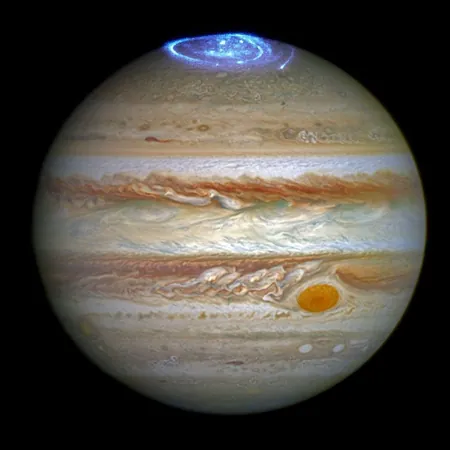
Unveiling Jupiter's Mysteries: Spectacular New Plasma Waves Discovered!
2025-08-30
Author: Jia
Revolutionary Discovery in Jupiter's Polar Regions!
A team of scientists from the University of Minnesota has made a groundbreaking discovery in the polar regions of Jupiter. They've identified a completely new type of plasma wave, creating auroras that are unlike anything seen here on Earth!
A Clash of Giants: Comparing Earth and Jupiter's Auroras
While Earth's beautiful northern and southern lights dazzle us in shades of green and blue, Jupiter's auroras operate in a realm of extremes. The gas giant's immense size, rapid rotation, and powerful magnetic field turn it into a natural laboratory for astonishing physics.
NASA's Juno: A Game-Changer in Space Exploration
The revelation comes from NASA's Juno spacecraft, which has achieved an impressive milestone as the first probe to orbit Jupiter's poles. What Juno has uncovered challenges long-standing assumptions about auroras, derived mainly from observations here on Earth.
What Is Plasma and Why Is It Crucial?
At the heart of this discovery lies the fascinating nature of plasma—a state of matter where gas becomes so heated that atoms split into electrons and ions. Jupiter's polar regions host an 'invisible ocean' of these charged particles, which accelerate downwards, igniting upper atmospheric gases and fueling dazzling auroras.
The Experts Weigh In: Understanding the Phenomenon
Leading the investigation, Professor Robert Lysak collaborated with astronomers Ali Sulaiman and Sadie Elliott to unravel Juno's data. They found that Jupiter's unique environment, marked by a fierce magnetic field and low plasma density, spawned these unprecedented plasma waves.
Alfvén Waves: The Key Players in Aurora Formation
Central to the phenomenon are Alfvén waves, theorized in 1942 by physicist Hannes Alfvén. The team's data showed that these waves vibrate at a much lower frequency in Jupiter's polar regions compared to similar waves on Earth, leading to striking differences in auroral display.
The Stark Contrast: Earth vs. Jupiter's Auroras
In contrast to Earth's typical donut-shaped auroral activity around the polar caps, Jupiter's auroras light up the poles themselves, flooding them with stunning visuals instead of leaving them dark. This radical difference is fueled by Jupiter's complex magnetic field.
Jupiter's Aurora: Invisible Yet Extraordinary!
Unlike the vibrant colors observable on Earth, Jupiter's aurora is less visible to the naked eye, often requiring ultraviolet and infrared instruments to unveil its splendor. Their composition is drastically different, emerging from the unique conditions present in the gas giant's atmosphere.
Expanding Our Understanding of Planetary Physics
This discovery not only sheds light on auroras on Jupiter but also expands our knowledge of plasma physics under extreme conditions. Such insights could have significant implications for fusion energy research and predicting space weather.
What’s Next? Future Missions to Unlock More Mysteries!
As Juno continues its mission, scientists are excited about future explorations, like the upcoming JUICE and Europa Clipper missions, slated for the late 2020s. These missions promise to enhance our understanding of Jupiter's complex magnetosphere and its cosmic environment.




 Brasil (PT)
Brasil (PT)
 Canada (EN)
Canada (EN)
 Chile (ES)
Chile (ES)
 Česko (CS)
Česko (CS)
 대한민국 (KO)
대한민국 (KO)
 España (ES)
España (ES)
 France (FR)
France (FR)
 Hong Kong (EN)
Hong Kong (EN)
 Italia (IT)
Italia (IT)
 日本 (JA)
日本 (JA)
 Magyarország (HU)
Magyarország (HU)
 Norge (NO)
Norge (NO)
 Polska (PL)
Polska (PL)
 Schweiz (DE)
Schweiz (DE)
 Singapore (EN)
Singapore (EN)
 Sverige (SV)
Sverige (SV)
 Suomi (FI)
Suomi (FI)
 Türkiye (TR)
Türkiye (TR)
 الإمارات العربية المتحدة (AR)
الإمارات العربية المتحدة (AR)